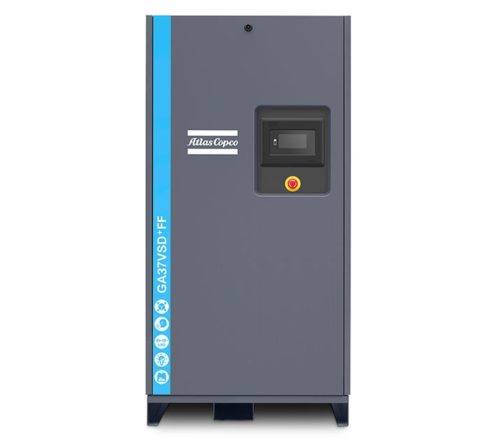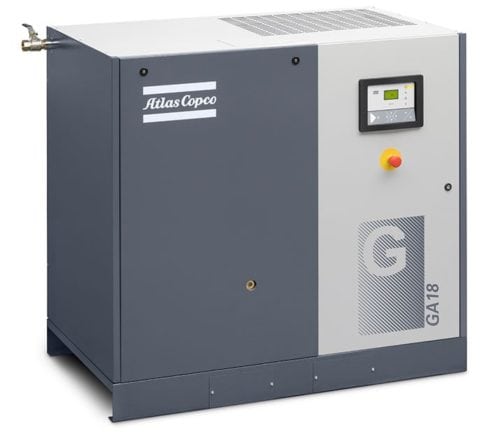At Airmatic Compressor Systems, we are the largest distributor of air compressors and vacuum pumps in New Jersey. We’ve put together the following article as an introduction to air compressors. It covers topics, such as how they work, types available, typical applications, key benefits, and recent technological developments, to help customers understand which industrial air compressor they should use for their compressed air needs.
How Do Air Compressors Work?
 Air compressors are devices designed to reduce the space occupied by air. While they are available in several designs and configurations, all variations rely on the same four basic components:
Air compressors are devices designed to reduce the space occupied by air. While they are available in several designs and configurations, all variations rely on the same four basic components:
- Motor: generates the power to drive the pump
- Pump: takes in air and compresses it
- Controller: manages the output flow and pressure of the air
- Tank: stores compressed air until it is needed
Types of Air Compressors
As indicated above, industrial air compressors come in numerous technologies, each of which demonstrates unique characteristics that make it suitable for different applications. Some of the most commonly available are:
- Rotary screw compressors. These compressors rely on two mesh screw drives rotating in opposite directions to build up the air pressure within the compressor housing. They are suitable for continuous use in industrial operations. Oil-injected and oil-free models are available to suit different application environments.
- Reciprocating air compressors. These compressors utilize a piston and cylinder assembly that displaces and compresses air to build up the air pressure. They are suitable for non-continuous use in smaller-scale applications (e.g., home renovation).
- Scroll compressors. These compressors employ two interleaving scrolls—one moving and one stationary—to pressurize gas. They are commonly used in intermittent duty and clean air applications.
- Centrifugal compressors. These compressors use a rotating impeller to transfer energy to the air. They are generally employed in higher flow, demanding industrial applications, such as chemical processing or steel manufacturing.
- Vane compressors. These compressors feature a rotor with radial vanes mounted in a stator housing. They offer efficient and quiet operation.
Applications of Air Compressors
 Air compressors are highly versatile pieces of equipment. They are used for a wide range of applications in nearly every industry. Some examples of typical applications include energy transference in actuators, air blasting, and material transference.
Air compressors are highly versatile pieces of equipment. They are used for a wide range of applications in nearly every industry. Some examples of typical applications include energy transference in actuators, air blasting, and material transference.
Energy Transference in Actuators
Pneumatic equipment relies on compressed gas to operate. The compressed gas is contained within actuators, which extend and contract to move the machinery as needed for the operation. Some of the industries that regularly use pneumatic equipment include agriculture, food and beverage processing, manufacturing, medical, and oil and gas. Compared to hydraulic and electrical equipment, it offers safer and cleaner operation.
Air Blasting for Cleaning & Cooling
Air compressors are used for a variety of cleaning and cooling applications. For cleaning operations, they are commonly integrated into sandblasters, pressure washers, and other similar equipment. These machines are employed in construction, repair, and other build and assembly operations to remove surface contaminations and imperfections from workpieces. For cooling operations, they are often used in refrigerant systems to lower the temperature of products (e.g., food) or localized areas (e.g., engines).
Material Transference
Air compressors are found in a wide range of material transfer equipment. This equipment, in turn, is used for a variety of industrial and commercial applications. For example, it is used in the food and beverage, manufacturing, and pharmaceutical sectors to place, position, and push materials and products along the production line. Secondly, compressed air is used to transfer food grains, powders, plastic pellets, and other materials by adding the material to be moved into the compressed air stream in a tube or pipe.
Advantages of Air Tools
Compared to electrically powered tools, pneumatically powered tools offer a number of advantages, such as:
- Smaller footprint. Pneumatic tools do not require a built-in motor. They can be connected to a compatible standalone motor as needed. As a result, they can have smaller designs, which means smaller storage space requirements and better maneuverability.
- Lower risk of sparking. Unlike electrical tools, pneumatic tools do not carry the risk of sparking during operation. This quality is particularly beneficial in environments containing flammable compounds.
- Greater power. Pneumatic tools offer greater torque capabilities than similarly sized electrical tools.
- Longer service life. Air tools have simpler designs than electrical tools, making them easier to maintain and repair. When maintained properly, they can last for years or decades.
New Innovations in Air Compressor Technology
Over the years, air compressor manufacturers have developed and introduced new technology to accommodate changing customer demands. Some of the most recent innovations in air compressor technology include:
- High-performance motors. New motor designs allow air compressors to offer greater output per horsepower, allowing industry professionals to invest in smaller—and cheaper—units.
- Advanced controllers. Advanced control components, including IoT (Internet of Things) technology, make it easier for industry professionals to monitor and manage equipment performance.
- Variable speed drives. Variable speed drives enable air compressors to automatically alter operations to accommodate current demand, resulting in lower energy costs.
Contact the Compressed Air Specialists at Airmatic Compressor Today
Airmatic Compressor Systems is an authorized distributor of air compressors and vacuum equipment. In addition to our sales capabilities, we also offer equipment repair, maintenance and system performance measurement for all of our products.
To learn more about our air compressor products, visit our product page. To discuss your application requirements with one of our experts, contact us or request a quote today.
